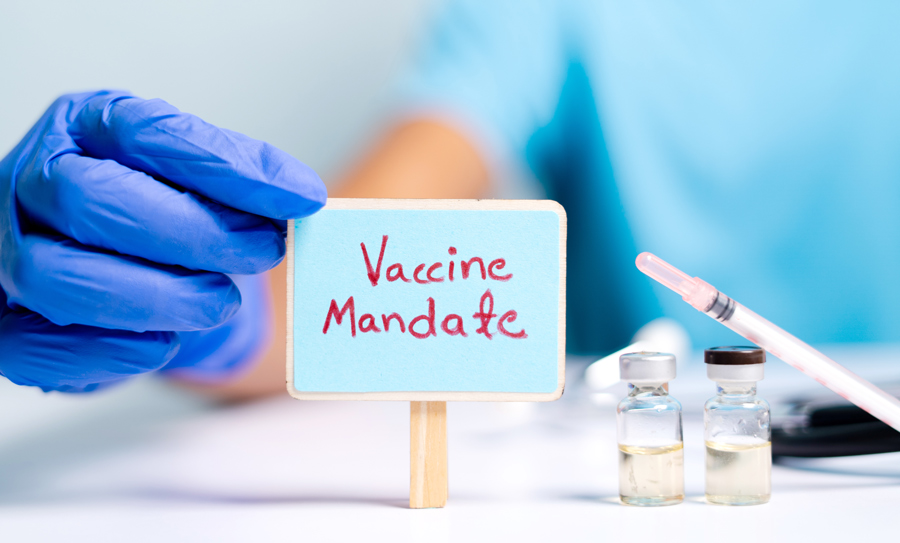According to Gov. Newsom, the mandate will go into effect once all the ages of students in grade spans 7-12 or K-6 are eligible to receive a COVID-19 vaccine that has been fully authorized for that age group by the Food and Drug Administration, and after the regulatory process, once initiated by CDPH, is complete. Although Pfizer has received full authorization for its COVID-19 vaccine for ages 16 and up, being vaccinated has not been required for students of that age group to attend school. Under Gov. Newsom’s proposal, if a COVID-19 vaccine is given full authorization for ages 12-15 before July 1, 2022, and if CDPH completes the regulatory process before July 1, the vaccination could then be required for students in grades 7-12 to attend school unless they have a medical or personal belief exemption. If approved after June 30 but before Dec. 31, 2022, it could then be required for students in grades 7-12 to return to school in January 2023.
Unlike the other 10 vaccines currently required by statute for enrollment, for any vaccine required prior to enrollment per a CDPH regulation, students will be eligible to use either the medical or personal belief exemption. (Health & Safety Code §§120335, 120338, 120372.)
CDPH met with stakeholders on Feb. 11, 2022, and announced that, once any vaccine is fully authorized for ages 12-15, the agency intends to initiate the emergency regulation process as provided for in the Administrative Procedures Act (APA). (Government Code §§ 11346.1, 11349.6; 1 CCR 48-56.) For context, the APA “rulemaking” process provides the process for California administrative agencies, such as CDPH, to adopt regulations to enforce or interpret a statute that governs subject matter areas under the administrative agency’s jurisdiction. The regular rulemaking process can take months, if not years, to complete. Among other requirements, the APA requires that the public has a minimum of 45 days to comment on a proposed regulation. The agency also has the option to hold a public hearing on the proposed regulation, with 45 days’ notice to the public. If the agency makes substantial revisions to the proposed regulation based on public comment, then an additional 15-day public comment period applies. Once complete, the Office of Administrative Law (OAL) must review the agency’s action to ensure it met the requirements of the APA.

Regardless of whether a public comment period is provided, OAL has 10 calendar days following the submittal of the proposed regulation within which to review and make a decision on an agency’s proposed emergency regulation — in this case a regulation or regulations regarding a vaccine mandate for students. Upon approval, OAL may file the approved regulation with the Secretary of State, and the regulation becomes effective upon that filing date. If OAL disapproves the regulation, it must prepare a written decision explaining the reasons for its disapproval. All in all, the CDPH emergency regulations mandating a COVID-19 vaccine for students could become effective as soon as 10 calendar days following CDPH’s submission of its proposed regulation(s) to OAL without a public hearing, and with or without OAL receiving and considering written public comments.
Once adopted, the regulations will be in effect for 180 days and deemed repealed after that time, unless CDPH requests a readoption of the regulations from OAL. (Government Code §11346.1, subd. (e).) CDPH may receive up to two readoptions of up to 90 days each if: (1) the emergency regulations to be readopted are the same as or substantially equivalent to the original emergency regulations; and (2) the agency has made substantial progress and proceeded with diligence to comply with the regular rulemaking process. (Government Code § 11346.1, subd. (h).) This would allow the regulations to be in effect for 360 days.
In a situation where the emergency regulation process has already been used, the Cal/OSHA Emergency Temporary Standards for COVID-19, the Governor issued an executive order allowing Cal/OSHA to have a third readoption and for that readoption period to last more than 90 days. CSBA will keep members posted as to whether that process will be used for the CDPH emergency regulations for student vaccines.
The regulations can become permanent if CDPH follows the regular, non-emergency rulemaking process described above so long as it does so while the emergency regulations are in effect. The regulations could also be superseded by legislation, including Sen. Richard Pan’s bill, Senate Bill 871, which would add COVID-19 to the list of diseases in Health and Safety Code §120335 for which students must be vaccinated in order to attend school.